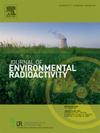山核桃生物炭对锝和碘(I−,IO3−和有机I)的吸收
IF 1.9
3区 环境科学与生态学
Q3 ENVIRONMENTAL SCIENCES
引用次数: 0
摘要
修复受到高风险阴离子放射性核素污染的土地和地下水,如碘-129 (I-129)和锝-99 (Tc-99),仍然是一个棘手的问题。本研究的目的是评估生物炭材料作为Tc-99和三种碘(碘化物/碘酸盐/有机碘(org-I))的低成本和有效的吸附剂。以山核桃壳为原料,经过两种热解温度(500°C和700°C)和两种酸活化(H3PO4和HCl)的生物炭为吸附材料进行了吸附研究。酸活化生物炭对Tc-99和不同种类碘的吸附能力(以分配系数Kd、固液浓度比为单位)明显高于非酸活化生物炭。h3po4活化的生物炭(500℃)是最有效的吸附剂,Tc-99 Kd为49,390±14,268 mL/g,碘化物Kd为2433±312 mL/g,碘酸盐Kd为410±168 mL/g, org-I Kd为857±181 mL/g。700°C时,盐酸活化的生物炭对Tc-99 (Kd为7864±5585 mL/g)和碘化物(Kd为2481±237 mL/g)也有效,但对碘酸盐/org-I无效。固体13c核磁共振(NMR)分析表明,其较强的吸附能力与形成丰富的烯烃、芳烃和杂芳烃官能团有关,傅里叶变换红外光谱(FTIR)分析也支持了这一结论。此外,FTIR结果表明,碳- h可能被碘亲电取代形成碳- i键。表面积测量和SEM图像表明,h3po4活化的生物炭(500°C)具有特别高的表面积。功能化生物炭可以作为一种经济有效的吸附剂,从生物圈中隔离I-129和Tc-99,从而降低人类的风险。本文章由计算机程序翻译,如有差异,请以英文原文为准。

Uptake of technetium and iodine (I−, IO3− and organo-I) by pecan biochar
Remediation of land and groundwater that are contaminated with high-risk driving anionic-radionuclides, such as iodine-129 (I-129) and technetium-99 (Tc-99), remains an intractable problem. The objective of this study was to evaluate biochar materials as a low-cost and effective sorbent for Tc-99 and three iodine species, iodide/iodate/organo-iodine (org-I). Sorption studies were conducted with biochar derived from pecan shells (Carya illinoinensis), that underwent two pyrolysis temperatures (500 °C and 700 °C) and two types of acid-activation (H3PO4 and HCl). Acid-activated biochar had much higher sorption capacities (in terms of distribution coefficient, Kd, the concentration ratio of solid:liquid) for Tc-99 and different iodine species, than non-acid-activated biochar. The H3PO4-activated biochar (500 °C) was the most effective sorbent with Tc-99 Kd of 49,390 ± 14,268 mL/g, iodide Kd of 2433 ± 312 mL/g, iodate Kd of 410 ± 168 mL/g, and org-I Kd of 857 ± 181 mL/g. The HCl-activated biochar (700 °C) was also effective at sequestering Tc-99 (Kd of 7864 ± 5,585 mL/g) and iodide (Kd of 2481 ± 237 mL/g) but not for iodate/org-I. Solid-state 13C-nuclear magnetic resonance (NMR) analysis suggested the strong sorption capacity related to the formation of abundant alkene, aromatic and heteroaromatic functional groups, which was also supported by the Fourier-transform infrared spectroscopy (FTIR) analysis. Additionally, the FTIR suggested the possible electrophilic substitution of C-H by iodine to form C-I bond. Surface area measurements and SEM images indicated the H3PO4-activated biochar (500 °C) had especially high surfaces areas. Functionalized biochar may provide a cost effective and efficient sorbent for sequestering I-129 and Tc-99 from the biosphere, thereby reducing human risk.
求助全文
通过发布文献求助,成功后即可免费获取论文全文。
去求助
来源期刊

Journal of environmental radioactivity
环境科学-环境科学
CiteScore
4.70
自引率
13.00%
发文量
209
审稿时长
73 days
期刊介绍:
The Journal of Environmental Radioactivity provides a coherent international forum for publication of original research or review papers on any aspect of the occurrence of radioactivity in natural systems.
Relevant subject areas range from applications of environmental radionuclides as mechanistic or timescale tracers of natural processes to assessments of the radioecological or radiological effects of ambient radioactivity. Papers deal with naturally occurring nuclides or with those created and released by man through nuclear weapons manufacture and testing, energy production, fuel-cycle technology, etc. Reports on radioactivity in the oceans, sediments, rivers, lakes, groundwaters, soils, atmosphere and all divisions of the biosphere are welcomed, but these should not simply be of a monitoring nature unless the data are particularly innovative.
 求助内容:
求助内容: 应助结果提醒方式:
应助结果提醒方式:


